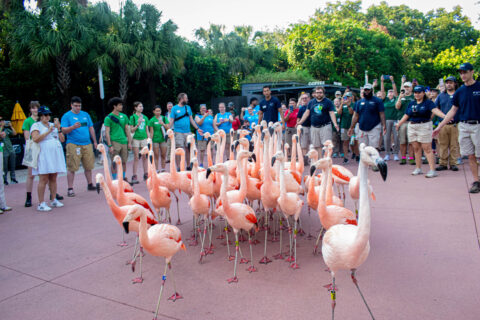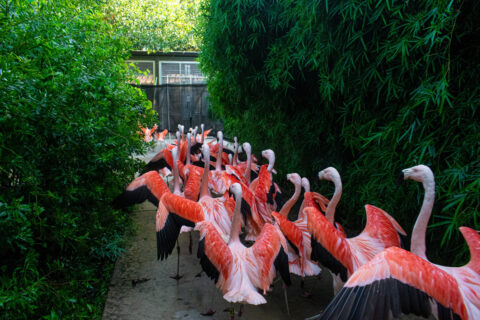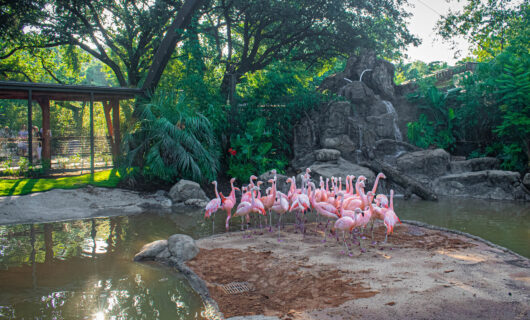Houston Zoo Flamingos Move into New Home
New Birds of the World Exhibit Opens Labor Day Weekend

On Tuesday, June 11, Houston Zoo’s flamingo flock walked through the Zoo to take up residence in their new and improved forever home. Approximately 200 Zoo staff, volunteers, and board members stood side by side to form a human wall to help navigate the Zoo’s 54 Chilean flamingos to the brand-new South American Wetlands aviary. This is one of the three new aviaries inside the Zoo’s newest 1.3 acre, $13.5 million Birds of the World exhibit, opening to guests August 30, 2024.
Birds of the World at the Houston Zoo will feature three spacious aviaries, and each housing approximately 15 different bird species.
- The South American Wetlands habitat is an immersive aviary, giving guests the chance to walk among spectacular variety of South American birds including a perennial favorite, Chilean flamingos. This aviary features a unique double-arched mesh enclosure which creates a walk-through aviary experience. Guests will see the historical sculptural tree created by Mexican American artist Dionicio Rodriguez, who was commissioned to make the sculpture by the City of Houston in 1926.
- The African Savanna aviary highlights majestic, grey-crowned cranes. It features a themed watering hole and artificial carcass feeder that will allow the vultures to exhibit carrion feeding. Carrion feeding is when scavengers eat the rotting flesh of a dead animal. This feeder is designed to allow the vultures to extend their heads into the “carcass” like they would in the wild.
- The North American Woodlands exhibit features a variety of American songbirds including blue grosbeaks and indigo buntings, helping connect visitors to the beautiful birds in their own backyard. It uses exclusively native plants, like American beautyberry, that will also provide nutritional enrichment to the animals

Additionally, a brand-new, state-of-the-art Avian Conservation Environment (ACE) building will provide updated spaces for our bird care professionals’ day-to-day activities, including behind the-scenes breeding programs of critically endangered species like the blue-billed curassow and Saint Vincent parrot. Houston Zoo has long been an innovator in the care and conservation of a wide range of birds, and this new complex will elevate and expand that leadership.

Saving Wild Birds
By visiting Birds of the Worlds at the Houston Zoo, guests learn how to protect wild birds. Birds from all over the world travel through Houston during their migration. Houston is on an international route for migrating birds. A billion birds fly through our night skies each season. Bright lights can cause confusion and collision with windows. One small way to help keep migrating birds safe is to turn out lights from 11:00 p.m. to 6:00 a.m. during bird migration season.
Houston Zoo helps save birds locally and internationally. Native birds are protected by law, when rescued from the illegal pet trade, they need a safe place to stay. The Houston Zoo partners with U.S. Fish and Wildlife to house these birds. The Zoo also cares for birds that have been injured and cannot be returned to the wild. At the Zoo, each cup of coffee helps protect wild birds by serving bird-friendly coffee. Bird-friendly coffee is grown in a way to preserve the habitats of birds and other animals in South America and beyond.
Abroad, in Rwanda, cranes are kept inappropriately as pets, causing wild flocks to decline. Houston Zoo’s conservation partners encourage the return of these birds for rehabilitation and rewilding. With the Zoo’s support, hundreds of cranes have been restored to the wild. A portion of each Zoo membership and ticket helps support the Zoo’s bird-saving initiatives.
